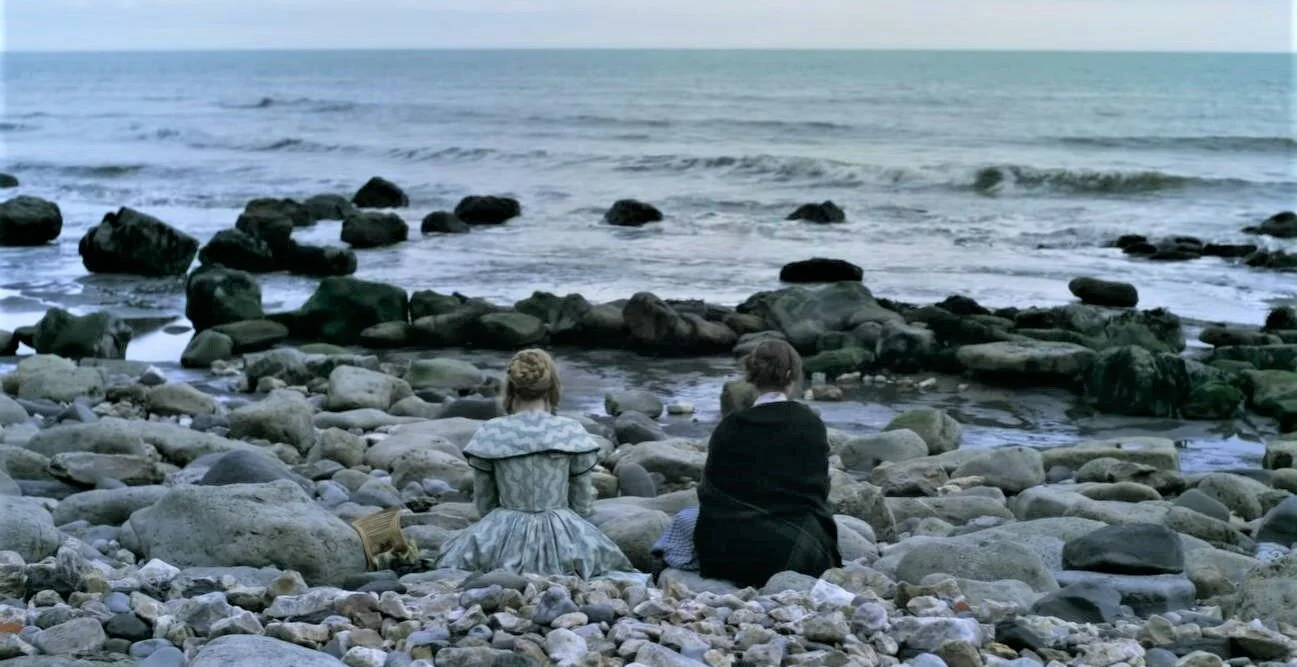Ammonite
Kate Winslet brings dignity, vulnerability and pain to a searing portrait of a woman ahead of her time.
On pebble beach: Saoirse Ronan and Kate Winslet
Kate Winslet and Saoirse Ronan are two of the finest actresses of their respective generations. For them to agree to star in Francis Lee’s sophomore feature is a testament to his standing as a cinematic force to reckon with. While Ammonite is unlikely to grab a mass audience by the lapels, it is a fiercely accomplished work that consumes the viewer through sheer authenticity and power of understatement. To employ an artistic metaphor, it is perhaps a miniature, or an impressionistic adaptation of a Vermeer or Hammershøi. Here, every nuance counts, as does every unanswered question and accidental touch. While vastly different in period and location to his first film, God’s Own Country (2017), Ammonite displays many parallels. Both films see opposites making human contact in stark, hostile environments and both explore subterranean emotion and even sexuality. And both showcase the director’s extraordinarily cinematic eye.
An ammonite is a fossil of an extinct mollusc from the Jurassic and Cretaceous periods, found in rock and displaying a frilled spiral form. And, as palaeontologists know only too well, they take enormous patience and skill to be coaxed out of their hiding places. Kate Winslet plays the real-life Mary Anning, one such palaeontologist, who devotes her days to roaming the beaches of Lyme Regis in Dorset in solitary pursuit of excavating the marvels of the past. She is standoffish, to say the least, and lives a spartan life with her elderly mother, Molly (Gemma Jones), to whom she barely speaks. In fact, in the early scenes, one might be forgiven for thinking that Mary is a mute. Then a gentleman and his wife turn up from London to pay their respects at Mary’s shop, an establishment that purveys run-of-the-mill fossils to tourists. He, Roderick Murchison (James McArdle), is hoping for an insight into Mary’s world, while his wife, Charlotte (Saoirse Ronan), who is suffering from mild melancholia, is encouraged to rest and take the sea air. Unable to accompany her husband on his work overseas, Charlotte stays behind in Lyme Regis, when her health takes a turn for the worse. Reluctantly, Mary puts her dislike for the younger woman to one side in order to help her recuperate…
Saoirse Ronan is already attracting Oscar buzz for her role as best supporting actress (which, in the event, would make it her fifth nomination), but it is Kate Winslet who truly inhabits her character. She is every inch the tough, working spinster, her distant demeanour concealing layers of historic hurt and disappointment. She is wedded to her work and has secured a significant niche in her male-dominated field, prompting one visitor to dub her “the reigning deity of Lyme.” From her gentle West Country burr to her grubby, hardened hands, Winslet’s Mary is a genuine product of 1840s’ Dorset. Her heart would seem to be as inflexible as the ammonite she digs up, so when she does, eventually, offer the shadow of a smile, it is an emotionally devastating moment.
While the film’s dramatic passages are more contained than in God’s Own Country – perhaps displaying a more feminine stance – the connection between Mary and Charlotte makes more sense. It was hard to comprehend what the Jesus-like Romanian migrant Gheorghe (Alec Secăreanu) saw in the self-serving alcoholic yob Johnny (Josh O’Connor) in Francis Lee’s first film. Here, we learn that Mary lost eight of her siblings and so she and her mother embark on a daily, wordless ritual of cleaning eight ornaments that Molly calls her “babies.” So maybe Charlotte’s vulnerability unlocks a maternal instinct in Mary’s stony nature, although Charlotte herself is keen to have children. Eschewing voice-over, exposition or captions, the film respects its audience’s intelligence by drip-feeding detail in almost subliminal moments, such as when Charlotte briefly fawns over a baby in the street. And to reinforce the film’s sense of realism, when Charlotte plays the piano, she does so less than proficiently. Dustin O'Halloran and Volker Bertelmann's background score is virtually non-existent – indeed, it’s not until Mary and Charlotte are first alone together that a note of music is heard. All of which adds up to an impression of overarching conviction, from the spare, austere interiors of the Annings’ house to the meticulous Lyme Regis street scenes. An original work of great sadness and economy, Ammonite rings with a terrible truth and an indictment of its period.
JAMES CAMERON-WILSON
Cast: Kate Winslet, Saoirse Ronan, Gemma Jones, James McArdle, Alec Secăreanu, Fiona Shaw, Claire Rushbrook, Wendy Nottingham.
Dir Francis Lee, Pro Iain Canning, Emile Sherman and Fodhla Cronin O'Reilly, Screenplay Francis Lee, Ph Stéphane Fontaine, Pro Des Sarah Finlay, Ed Chris Wyatt, Music Dustin O'Halloran and Volker Bertelmann, Costumes Michael O’Connor, Dialect coach Laura Hart.
BBC Films/British Film Institute/See-Saw Films-Lionsgate.
117 mins. UK/Australia/USA. 2020. Rel: 26 March 2021. Cert. 15.


